Increasing swing speed in golf is crucial for boosting your overall performance on the course. By focusing on specific techniques and exercises, you can maximize your swing speed and achieve greater distance and accuracy. In this guide, we will explore various strategies and tips to help you increase your swing speed and unlock your full potential as a golfer.
Key Takeaways:
- Enhancing swing speed in golf can lead to greater distance and accuracy.
- A golfer’s mindset plays a significant role in driving performance.
- The Confident-T drill and toe-first contact can boost clubhead speed.
- The Fireball drill helps train your body to swing faster.
- Relaxing the lead arm and improving physical fitness contribute to increased swing speed.
The Importance of Mindset in Driving Performance
In the game of golf, mindset plays a crucial role in driving performance. The way we think and approach each shot can have a significant influence on our ability to hit the ball accurately and achieve greater distance. It’s essential to understand the impact that our mindset can have on our swing speed and overall game.
When it comes to driving performance, focusing on distance over accuracy can be a game-changer. By adopting a free-wheeling mindset and prioritizing sequencing and ball speed, golfers can improve their swing speed and unlock their distance potential. Emphasizing distance can lead to better sequencing, increasing clubhead speed and overall performance.
It’s important to remember that mindset alone won’t guarantee success on the course. Practice and technique are still crucial factors. However, by cultivating a positive and focused mindset, golfers can enhance their driving performance, improve accuracy and distance, and ultimately take their game to new heights.
Quotes:
“When I started focusing on distance and ball speed, my swing speed naturally increased, and I saw a significant improvement in my performance on the course.” – Professional Golfer
“A positive mindset and the confidence to go for distance can help golfers unlock their full potential and achieve greater success in their driving performance.” – Golf Coach
The Confident-T Drill for Boosting Clubhead Speed
When it comes to increasing your clubhead speed and maximizing distance in your golf swing, the Confident-T drill is a must-try exercise. This research-based drill focuses on improving upper-body extension and enhancing clubhead speed. By incorporating this drill into your practice routine, you can unlock your full potential and take your swing to new heights.
The Confident-T drill involves assuming a normal posture with your arms extended, forming the shape of the letter T. As you turn and coil your upper body back, allow your arms to tilt. This helps improve the proper upper-body extension through the ball, enabling you to swing from inside the target line and generate more power. As you swing forward, focus on pushing off the ground with your legs and expanding your chest, further enhancing your clubhead speed.
This drill is highly effective in improving swing mechanics and increasing swing speed. By practicing the Confident-T drill regularly, you can make significant strides in boosting your clubhead speed, improving upper-body extension, and maximizing distance potential. Incorporate this drill into your training regimen and see the difference it makes in your overall golf performance.
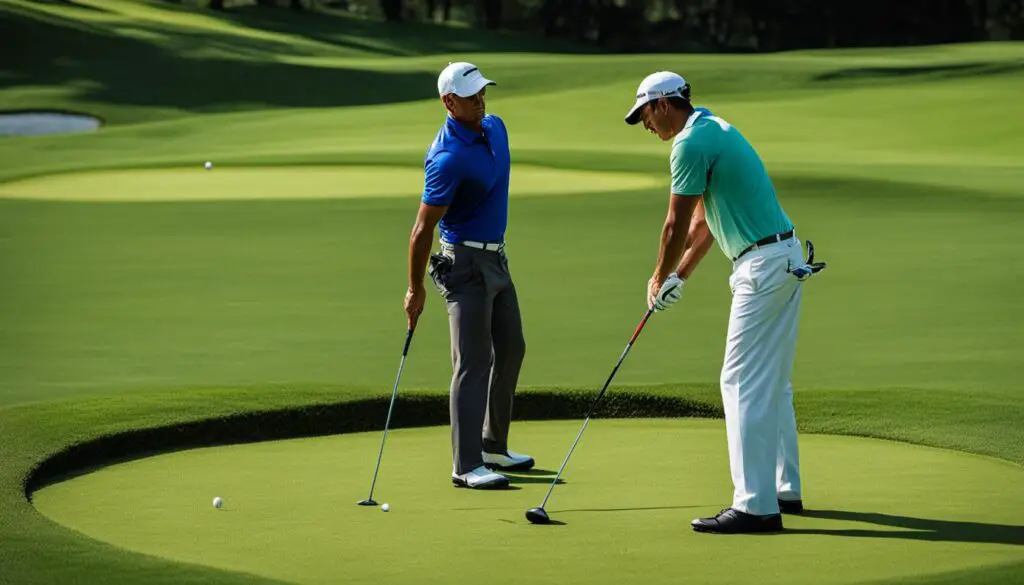
Key benefits of the Confident-T drill:
- Enhances upper-body extension in the golf swing
- Improves swing mechanics and sequencing
- Increases clubhead speed and distance potential
- Helps swing from inside the target line for better accuracy
- Builds strength and stability in the swing
Improving Clubface Control for Increased Swing Speed
One of the key factors in increasing swing speed in golf is improving clubface control. Many golfers struggle with steering the clubface through impact, resulting in slices and a loss of clubhead speed. By addressing this issue and making a simple adjustment, you can not only enhance clubface control but also gain valuable clubhead speed, leading to significant improvements in both distance and accuracy.
Creating Draw Spin
“Getting the toe of the clubhead to the ball first.”
To improve clubface control and gain more clubhead speed, focus on getting the toe of the clubhead to the ball before the heel. This technique involves over-rotating the clubface and pointing the toe down the fairway after impact. By doing so, you create more draw spin, which not only increases roll but also adds extra yardage to your shots. This simple adjustment can result in 2 to 3 miles per hour of additional clubhead speed, translating to longer and more powerful drives.
Increasing Roll Potential
“Creating draw spin enhances both distance and accuracy.”
In addition to creating draw spin, getting the toe of the clubhead to the ball first also increases roll potential. By hitting shots that promote a slight draw, you can optimize the launch angle and backspin, and achieve a more penetrating ball flight. This combination of factors results in increased roll distance after landing, ensuring every yard counts and maximizing the overall distance of your shots.
Improving clubface control is a fundamental aspect of increasing swing speed in golf. By focusing on techniques that create draw spin and increase roll potential, you can gain valuable clubhead speed and unlock your full potential on the course. Incorporate these adjustments into your practice routine and watch as your drives become longer, more accurate, and more powerful than ever before.
Swing Speed Training for Maximum Performance
To maximize your swing speed and unlock your full potential as a golfer, incorporating effective practice drills into your training routine is essential. These drills not only help improve your swing tempo but also enhance your overall swing speed and power. Here are some golf practice drills that can assist you in maximizing your swing speed and taking your game to the next level:
- The Over-Speed Drill: This drill involves swinging a lighter club or a weighted training aid. By using a lighter club, you can increase your swing speed and train your muscles to move faster. On the other hand, using a weighted training aid helps build strength and power, which translates into increased swing speed when using a regular club.
- The Speed Stick Drill: Speed sticks are specifically designed to improve swing speed. By incorporating speed sticks into your training routine, you can enhance your muscle activation, increase clubhead speed, and improve your overall swing tempo. Start with lighter speed sticks and gradually progress to heavier ones as your swing speed improves.
- The Impact Bag Drill: The impact bag drill focuses on improving the quality of your impact position, which is crucial for maximizing swing speed and power. By striking the impact bag with proper technique and force, you can develop a more efficient and powerful impact position, leading to increased swing speed and distance.
Remember, consistency and regular practice are key to improving your swing speed. Incorporate these golf practice drills into your training routine and monitor your progress over time. By focusing on maximizing your swing speed, you’ll be able to generate more power, achieve greater distance, and take your golf game to new heights.
Relaxing the Lead Arm for a Tension-Free Backswing
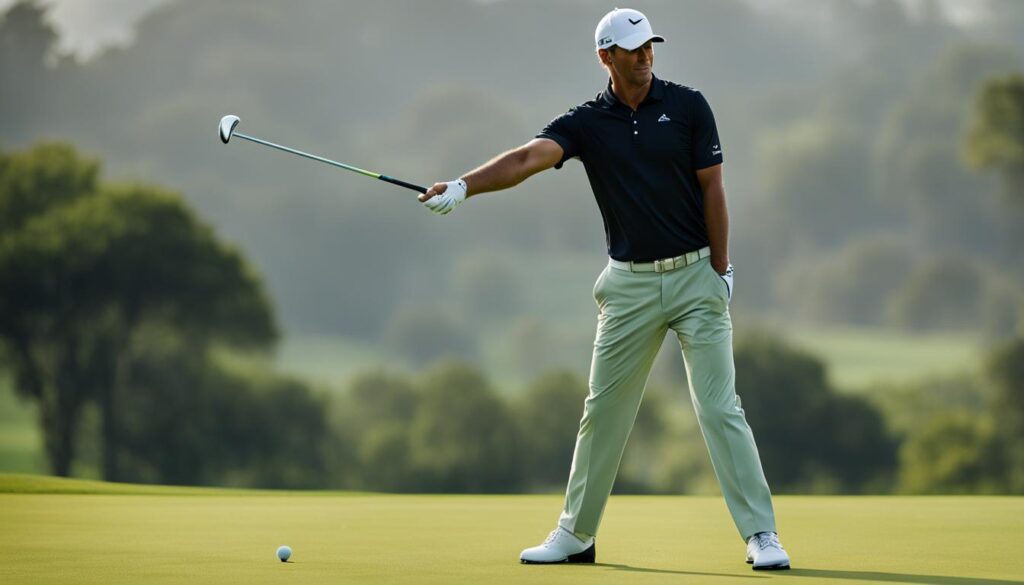
When it comes to improving your backswing in golf, many amateur golfers are advised to keep their lead arm straight. However, this can actually create tension in the back and restrict the swing, ultimately affecting your overall swing speed and power. Instead of focusing on a rigid lead arm, it is essential to keep the lead arm soft and relaxed, allowing for a slight bend at the elbow.
By maintaining a soft lead arm, you enable more freedom and flexibility in your backswing, which translates to a tension-free motion. Combine the turning of the hips with the shoulders on the backswing, avoiding any restrictions in the pelvis. This approach helps to loosen up the muscles, allowing for a more efficient transfer of power during the downswing.
By relaxing the lead arm and promoting a tension-free backswing, you can optimize your swing mechanics and increase your swing speed. The soft lead arm allows for more fluid movement, facilitating better hip and shoulder rotation and maximizing the potential energy stored during the backswing. As a result, you can generate more power and achieve greater distance and accuracy in your golf shots.
Improving Physical Fitness for Increased Swing Speed
Physical fitness plays a crucial role in enhancing swing speed and overall golf performance. By focusing on building lean muscle and improving strength and speed, golfers can increase their swing power and unlock their full potential on the course.
A well-rounded fitness routine that targets key muscle groups is essential for improving swing speed. Incorporating exercises that focus on the core, back, shoulders, biceps, legs, and glutes can provide a strong foundation for generating power in the golf swing. Strength training exercises such as squats, deadlifts, and shoulder presses can help build the necessary muscle strength, while explosive movements like medicine ball slams and kettlebell swings can improve overall power and speed.
In addition to strength training, incorporating speed and agility drills can also contribute to increased swing speed. Exercises such as ladder drills, cone drills, and plyometric exercises can help develop quickness, coordination, and explosive power, all of which are beneficial for generating speed in the golf swing.
In summary, prioritizing physical fitness and incorporating targeted strength and speed training exercises into your routine can significantly enhance your swing power and increase your overall swing speed. By building lean muscle, improving strength and speed, and focusing on key muscle groups, golfers can unlock their full potential and achieve greater distance and accuracy on the course.
The Role of Equipment in Increasing Swing Speed
When it comes to increasing swing speed in golf, having the right equipment is essential. A well-suited driver can significantly impact your clubhead speed, distance, and accuracy on the course. So, how do you choose the right equipment to maximize your swing potential?
Golf club selection is key. Look for a driver that suits your swing characteristics and preferences. Consider factors like clubhead size, loft angle, and shaft flex. The right clubhead size can provide a larger sweet spot, enhancing forgiveness and increasing clubhead speed. The loft angle should be adjusted to match your swing speed and launch conditions, optimizing distance and accuracy. And the shaft flex should be tailored to your swing tempo and strength, allowing for better energy transfer and increased swing speed.
In addition to the driver, other equipment choices can also impact your swing speed. The type of golf ball you use and the grip on your clubs can make a difference. Choose a ball that offers low spin and maximum distance for increased carry and roll. Ensure that your grips provide the right amount of tackiness and feel, allowing for a secure hold and better control of the club.
Remember, while the right equipment plays a significant role in increasing swing speed, it’s important to also focus on technique, physical fitness, and mindset. By combining all these elements, you can optimize your swing speed, unleash your potential, and take your golf game to new heights.
Utilizing Shot Shape for Maximum Distance
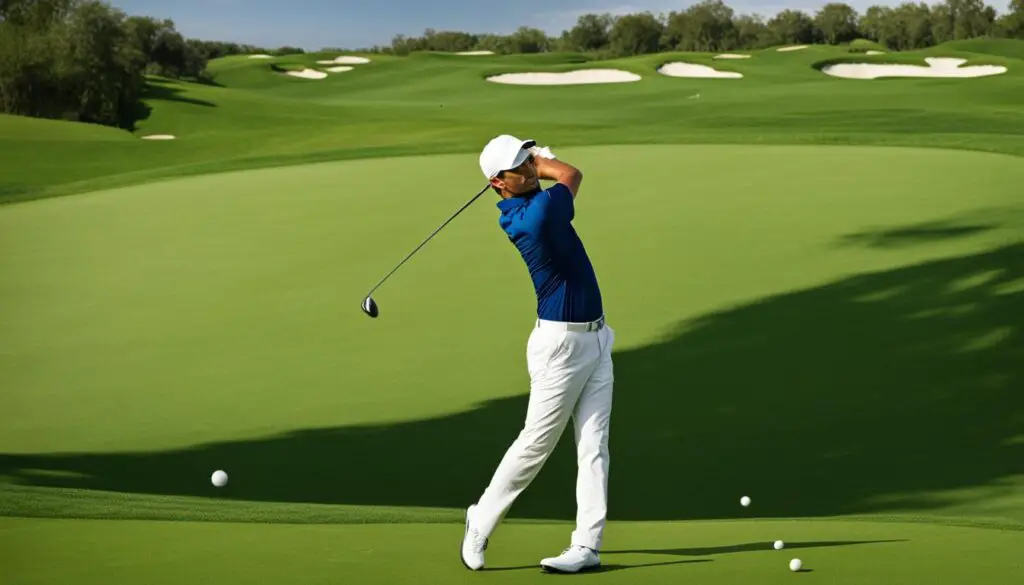
Understanding your natural shot shape can be a game-changer when it comes to maximizing distance and accuracy off the tee. Instead of fighting against your natural ball flight tendency, embracing and utilizing it to your advantage can lead to more effective ball striking and optimize your overall performance on the course.
Shot shaping involves intentionally curving the ball in a specific direction, such as a draw or a fade. By understanding your natural shot shape, whether it’s a big cut or a slight draw, you can adjust your aim and play to your strengths. This can help you hit the ball more effectively and reach more fairways, ultimately leading to increased distance on your shots.
Ball Flight Control
When utilizing shot shape for maximum distance, it’s important to have control over your ball flight. This means understanding how to adjust your aim, clubface angle, and swing path to produce the desired shot shape. Working with a golf instructor or coach can help you fine-tune your ball flight control and ensure you’re optimizing your swing for maximum distance.
By utilizing your natural shot shape and mastering ball flight control, you can strategically navigate the fairway, maximize fairway coverage, and place your shots in the best possible position for your next shot. This level of shot shaping expertise can take your game to new heights and help you unlock your full potential as a golfer.
Tee Height and Its Impact on Accuracy and Distance
When it comes to optimizing your golf game, the height at which you tee the ball can make a significant difference in both accuracy and distance. While many golfers may be tempted to tee the ball high for maximum distance, research suggests that pegging it slightly lower, about an inch and a half above the ground, can lead to better control and optimal launch conditions. By finding the right tee height, you can enhance your ball flight control and increase your roll distance, resulting in improved overall performance on the fairway.
Optimizing your tee height has several advantages. By teeing the ball lower, you have a better chance of hitting the sweet spot on the clubface, which promotes straighter shots and reduces the likelihood of mishits. It also encourages a more controlled and consistent swing, allowing you to focus on accuracy rather than solely relying on distance. Additionally, a lower tee height can help you optimize your launch angle, leading to an ideal trajectory that maximizes your roll distance and carries your shots farther down the fairway.
Incorporating a lower tee height into your game may require some adjustment and experimentation. Start by teeing the ball slightly lower than usual and see how it affects your shots. Pay attention to your ball flight and how it interacts with the fairway upon landing. You may find that a lower tee height not only enhances your accuracy but also allows you to achieve greater distance by optimizing the launch conditions of your shots. Fine-tuning your tee height to match your swing mechanics and preferences can be a game-changer in unlocking your full potential on the golf course.
The Benefits of Lower Tee Height:
- Improved ball flight control
- Enhanced accuracy and consistency
- Optimized launch angle
- Increased roll distance
“Finding the right tee height is a game of balance. It’s about finding the sweet spot where you can maintain control and accuracy while still maximizing your distance potential.” – Golf Pro
Experimenting with Tee Height:
- Start by teeing the ball slightly lower than usual, around an inch and a half above the ground.
- Observe the flight and landing of your shots to assess the impact of the lower tee height.
- Adjust the tee height as needed to find the optimal balance between accuracy, distance, and control.
- Continuously fine-tune your tee height based on your swing mechanics and personal preferences.
The Power of Wrist Hinge and Lag in the Golf Swing
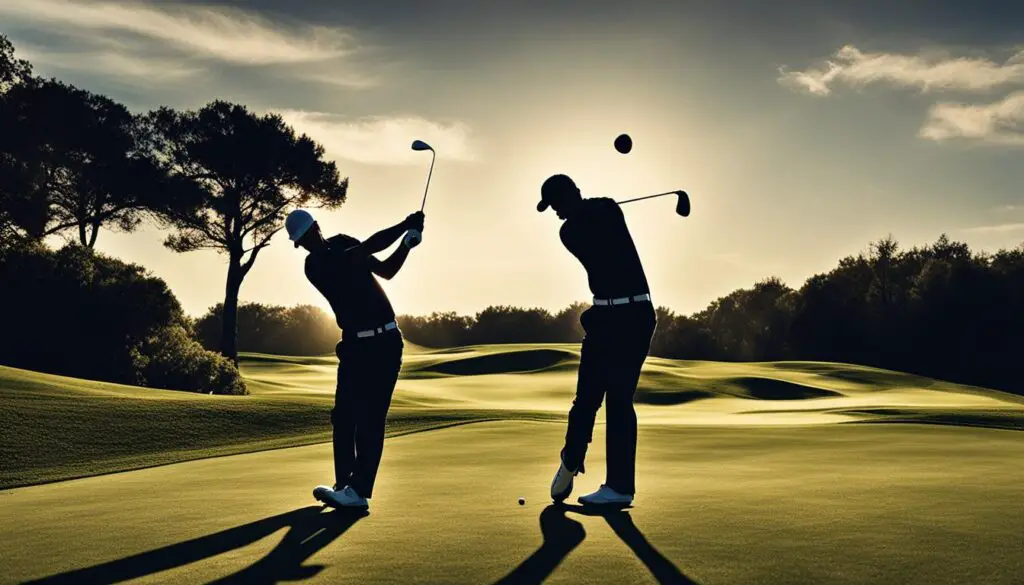
When it comes to increasing swing speed and delivering power to the ball in golf, understanding the importance of wrist hinge and maintaining lag is crucial. The wrist hinge refers to the movement of the wrists during the backswing, where they cock upwards to create potential energy. Maintaining lag involves delaying the release of the wrist hinge until the point of impact with the ball. These two elements work together to optimize the swing and generate maximum power.
By allowing your wrists to hinge at the top of your backswing, you create stored energy that can be unleashed as the clubhead accelerates through the downswing. This wrist hinge acts as a lever, amplifying the force generated by the swing and increasing clubhead speed. Additionally, by maintaining the lag between the wrists and the clubhead until impact, you can ensure that the power is efficiently transferred to the ball, resulting in greater distance and accuracy.
Proper wrist hinge and lag also play a crucial role in clubface control. By maintaining the hinge, you can keep the clubface square to the target and avoid unwanted manipulation that can lead to errant shots. This allows for more consistent and reliable ball striking, improving both distance and accuracy. So, the next time you tee it up, remember the power of wrist hinge and lag and watch as your swing speed and overall performance on the course improve.
Creating Lag for Increased Swing Speed
Creating lag in your golf swing is a technique that can significantly enhance your clubhead speed, accuracy, and distance. Lag refers to the angle between the club, wrists, and arms, and it allows for a more efficient transfer of power to the ball. By practicing and incorporating lag techniques into your swing, you can unleash the full potential of your drives and take your golf game to the next level.
One effective way to practice creating lag is by focusing on the proper wrist hinge. As you take the club back, allow your wrists to hinge naturally, creating an angle between the clubshaft and your forearms. This angle should be maintained until the point of impact, where you release the lag and unleash the stored power. By mastering this technique, you can generate more clubhead speed and maximize the power transfer to the ball.
“Creating lag in the golf swing is like cocking a gun. The more lag you have, the more power you can release at impact.”
Practicing lag techniques can be done both on and off the course. During your practice sessions, focus on exaggerating the feeling of lag and the sensation of storing and releasing power. You can also incorporate lag drills and exercises into your warm-up routine to reinforce the proper lag mechanics. By consistently working on creating lag, you can develop a more powerful and efficient swing that translates into increased swing speed, accuracy, and distance on the course.
Benefits of Creating Lag in Your Swing:
- Increased clubhead speed
- Improved accuracy and distance
- Maximized power transfer to the ball
- Enhanced control and consistency
Sources of Power in Golf Swing: Balancing Leverage, Width, and Rotation
When it comes to maximizing distance in your golf swing, understanding the sources of power is essential. These sources include leverage, width, and rotation, and by finding the right balance between them, you can optimize your swing and achieve greater swing speed and distance.
Firstly, leverage plays a crucial role in generating power. It is created through the angles formed by your wrists and arms during the swing. By utilizing these angles effectively, you can multiply the force and speed of your swing, resulting in greater distance off the tee.
Secondly, width refers to the size of your swing arc. A wider swing arc allows for more time to accelerate the club, generating additional clubhead speed. By maximizing the width of your swing, you can create a more powerful and efficient transfer of energy to the ball.
Finally, rotation is an important component of the golf swing, but it must be balanced with leverage and width. While rotation provides the rotational power necessary for generating speed, focusing solely on rotation can sacrifice the leverage and width in your swing. By finding the right balance between rotation, leverage, and width, you can optimize your power sources and unlock your full potential on the course.
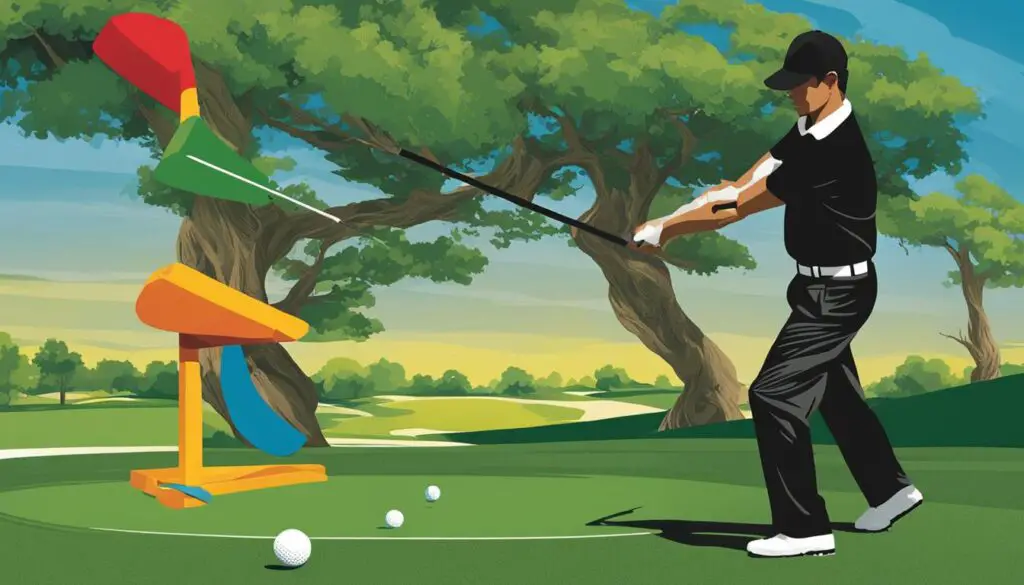
Key Points:
- Leverage, created through wrist and arm angles, multiplies force in the swing.
- Width, or the size of the swing arc, allows for greater time to accelerate the club.
- Rotation is important but must be balanced with leverage and width.
“By understanding and balancing these three sources, you can optimize your power and achieve greater swing speed and distance.”
The Role of Physical Fitness in Increasing Swing Speed
Increasing your swing speed in golf requires more than just mastering technique and strategy. Physical fitness plays a crucial role in enhancing your swing power and unlocking your full potential on the course. By engaging in specific exercises and targeted workouts, you can build the necessary strength and flexibility to generate a more powerful swing.
When it comes to golf fitness exercises, it’s important to focus on the muscle groups that are directly involved in your swing. Core exercises, such as reverse crunches and Superman stretches, help stabilize your torso and generate rotational power. Back and shoulder exercises, like cable crossovers and kettlebell swings, improve upper body strength and enhance your ability to generate clubhead speed. Additionally, exercises targeting the biceps, legs, and glutes, such as goblet squats and RDLs, contribute to overall power and stability in your swing.
Integrating swing speed workouts into your routine can also yield significant improvements. Battle ropes and medicine ball slams are effective for developing explosive power and increasing swing speed. Hip crossovers and box jumps can enhance lower body strength and coordination, resulting in a more dynamic swing. By incorporating these exercises into your training regimen, you can enhance your physical fitness and take your swing speed to new heights.
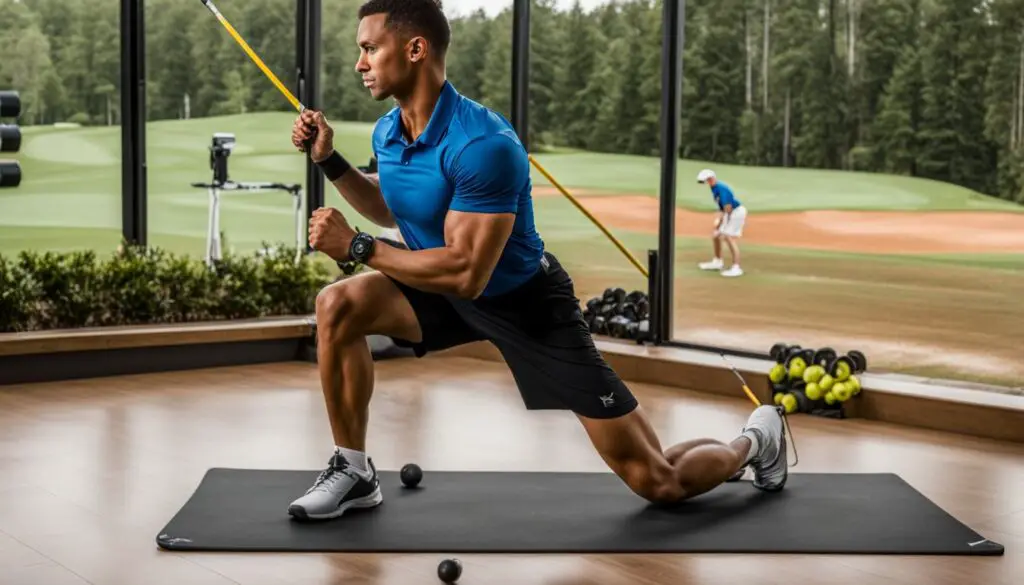
The Importance of Understanding the Sources of Clubhead Speed
When it comes to increasing your swing potential in golf, understanding the sources of clubhead speed is paramount. By focusing on three primary factors – leverage, width, and rotation – you can maximize your swing speed and unlock your full golfing potential.
Leverage plays a crucial role in generating power in your swing. By creating optimal wrist and arm angles, you can multiply the force and energy transferred to the clubhead. Visualize your wrists as the key to unlocking greater leverage and channeling that power into your swing.
Width, or the size of your swing arc, is another critical factor. A wider swing arc gives you more time to accelerate the club, resulting in increased clubhead speed. By prioritizing width in your swing, you can maximize the distance and velocity of your shots.
While rotation is important for generating power, it must be balanced with leverage and width. Avoid sacrificing these sources of speed by finding the right balance that works for you. By understanding and optimizing leverage, width, and rotation in your swing, you can dramatically increase your clubhead speed, improve the accuracy and distance of your shots, and take your golf game to new heights.
FAQ
How can I increase my swing speed in golf?
Increasing your swing speed in golf can be achieved through specific techniques and exercises, such as focusing on sequencing and ball speed, incorporating drills like the Confident-T Drill, and improving physical fitness.
What is the Confident-T Drill?
The Confident-T Drill is a research-based exercise designed to enhance clubhead speed and upper-body extension in the golf swing. It involves assuming a normal posture with arms extended, forming the letter T, and focusing on swinging from inside the target line to increase distance potential.
How can I improve my clubface control?
To improve clubface control and gain clubhead speed, focus on getting the toe of the clubhead to the ball before the heel. By over-rotating the clubface and pointing the toe down the fairway after impact, you can create more draw spin, increase roll, and gain clubhead speed.
How can I swing faster in golf?
The Fireball Drill is an effective method for training your body to swing faster. By taking five full swings with your driver at maximum speed, focusing on unrestricted mayhem, you can increase your swing speed subconsciously and learn to manage this energy for more powerful and faster swings.
Should I keep my lead arm straight during the backswing?
No, keeping the lead arm straight during the backswing can create tension and restrict your swing. Instead, focus on keeping a soft lead arm with a slight bend at the elbow. Combine this with hip and shoulder rotation to achieve a tension-free backswing and efficient transfer of power during the downswing.
How does physical fitness impact swing speed?
Physical fitness plays a crucial role in improving swing speed. By building strength and lean muscle through specific exercises targeting core, back, shoulders, biceps, legs, and glutes, you can enhance your overall golf performance and achieve a more powerful and faster swing.
How important is having the right equipment for swing speed?
Having the right equipment, especially a well-suited driver, is vital for maximizing swing speed and unlocking your full potential on the course. Investing in a good-quality driver that matches your swing characteristics can significantly increase clubhead speed, distance, and accuracy.
Should I utilize my natural shot shape?
Yes, understanding and utilizing your natural shot shape can be advantageous for maximizing distance and accuracy off the tee. Embracing your natural ball flight tendency, whether it’s a big cut or a slight draw, can help you hit the ball more effectively, reach more fairways, and optimize your overall performance on the course.
What is the impact of tee height on accuracy and distance?
Tee height can significantly impact the flight and landing of your shots. While it may be tempting to tee the ball high for maximum distance, pegging it slightly lower (about an inch and a half above the ground) can enhance accuracy and promote optimal launch conditions, resulting in better control and maximizing overall distance.
How can I optimize power and clubhead speed with my wrists?
Proper wrist hinge and maintaining lag in the golf swing are essential for generating maximum power and clubhead speed. By allowing your wrists to hinge at the top of the swing and maintaining that hinge until the point of impact, you can optimize your swing by keeping the clubface square and delivering more power to the ball.
How can I create lag to increase swing speed?
Creating lag in the golf swing is important for increased swing speed. By leveraging the wrist hinge and incorporating a full rotation of the hips, you can generate lag, which allows for the transfer of speed and power to the clubhead, resulting in improved accuracy, distance, and swing speed.
What are the sources of maximum distance in the golf swing?
Leverage, width, and rotation are the three primary sources of maximum distance in the golf swing. While many golfers focus solely on rotation, it’s important to balance and utilize all three sources effectively to optimize power, clubhead speed, and achieve greater distance.
How can physical fitness contribute to increasing swing speed?
Engaging in specific exercises and workouts targeting key muscle groups, such as the core, back, shoulders, biceps, legs, and glutes, can significantly contribute to increasing swing speed in golf. By focusing on fitness and incorporating these exercises into your routine, you can improve your swing speed and overall golf performance.
What is the role of understanding the sources of clubhead speed?
Understanding the sources of clubhead speed, which include leverage, width, and rotation, is crucial for maximizing your swing potential. By comprehending and utilizing all three sources effectively, you can increase clubhead speed, improve accuracy and distance, and take your golf game to the next level.
